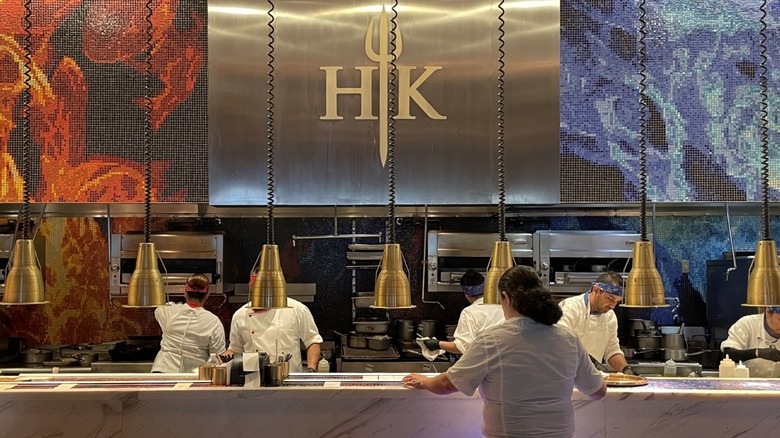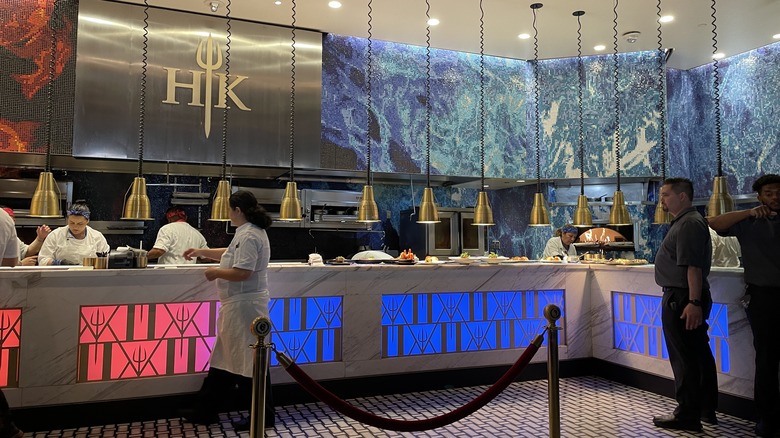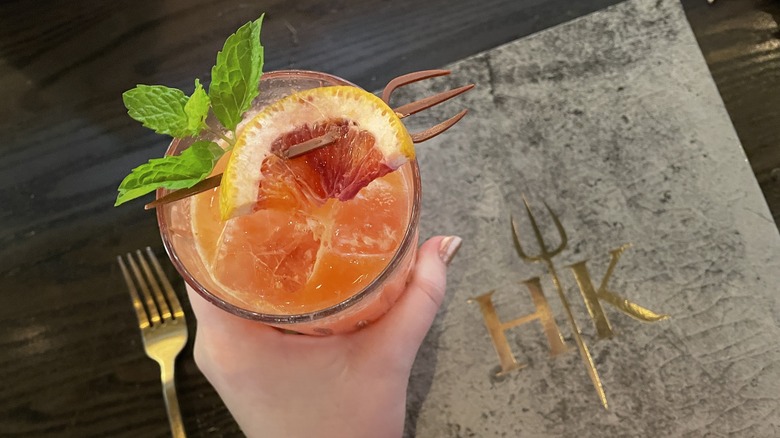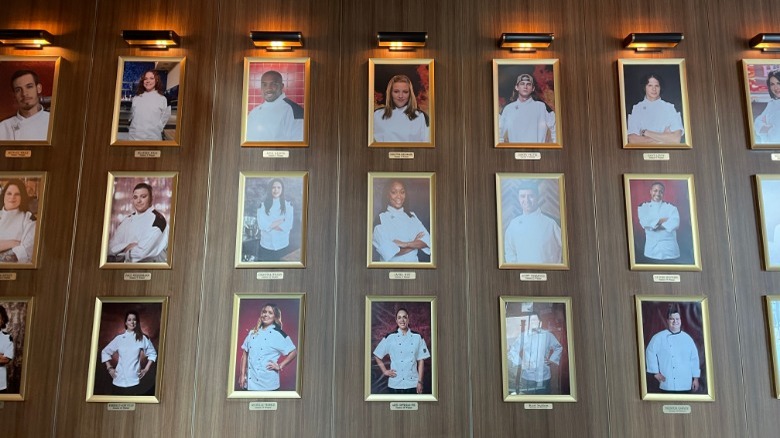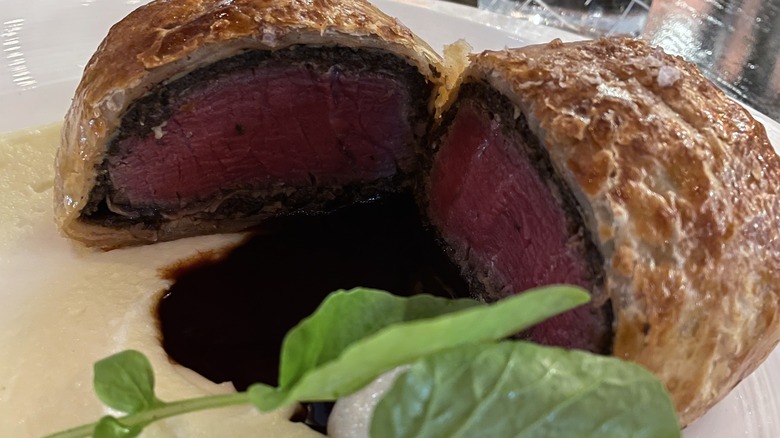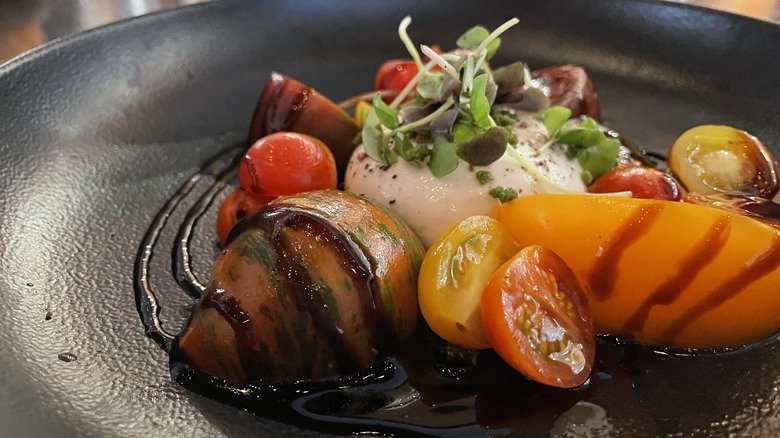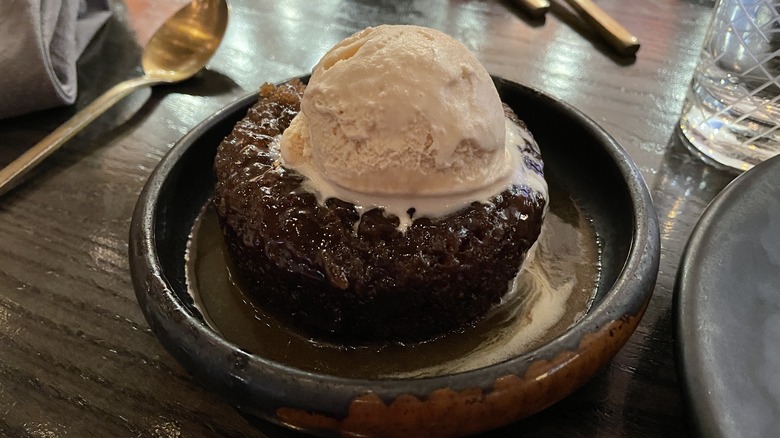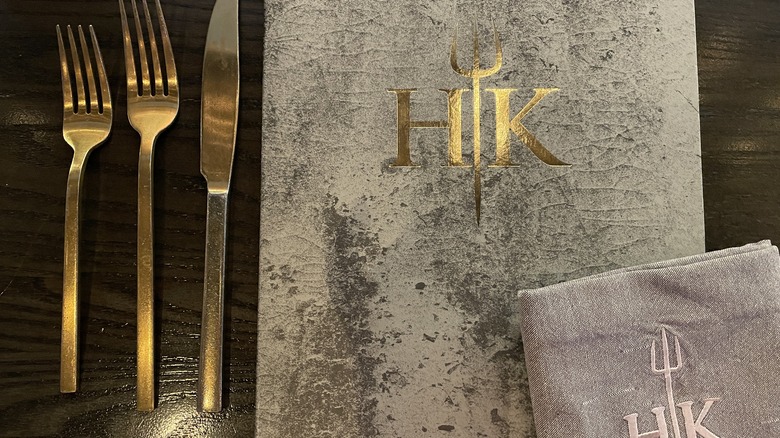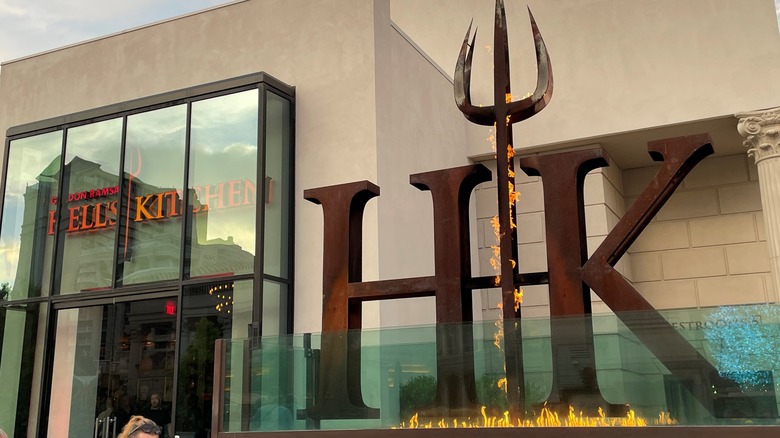What It's Really Like Behind The Scenes At A Gordon Ramsay Restaurant
It might surprise you to find out that Gordon Ramsay currently operates 53 restaurants worldwide, ranging in size and style from tiny sleek airport bars and spray-painted pizza joints in London to a one-of-a-kind Michelin-starred restaurant located in a breathtaking hotel in Bordeaux, France. Four of those restaurants are Hell's Kitchen restaurants, designed after the wildy popular 20-season show of the same name — where two teams battle it out and get whittled down until only one chef is left standing. The first of the TV-inspired restaurants was established in Las Vegas, followed by locations in Dubai, Lake Tahoe, and Southern California.
On a recent trip to Las Vegas, we got the opportunity to dine at Gordon Ramsay's busiest Hell's Kitchen restaurant, located at Caesar's Palace, with front-row seats to the action in the kitchen. Over the course of our meal, we tasted the restaurant's signature dishes, indulged in some of the infernal cocktails, and learned some interesting facts about how the restaurant actually operates on a daily basis from those in the know. This is everything we found out about what it's really like behind the scenes of one of Gordon Ramsay's most famous restaurants.
Hell's Kitchen Las Vegas is the training ground for chefs going to other locations
The first thing you'll notice when walking into the main dining room at Hell's Kitchen is the brightly lit open kitchen, designed just like the TV show, with a red team and blue team of chefs cooking food in front of huge mosaics of orange and blue flames. It was clear who the cooks were based on the signature Hell's Kitchen uniforms, but we were curious about who some of the other people working in the kitchen are. In front of the line are at least two sous chefs in crisp white chef's coats expediting service, and sending food out into the dining room.
There are also cooks working in the kitchen with gray aprons, a distinctly different look than the rest of the cooks. We were told that those are chefs training to open new Hell's Kitchen locations, and that this particular restaurant serves as the training ground and menu development center for all of the other locations. With four Hell's Kitchens currently in operation, and four more restaurants slated to open by the end of 2023 in Atlantic City, Washington D.C., Miami, and Chicago, there are plenty of people to train up in the Hell's Kitchen style. If you want to work at a high level in one of Ramsay's restaurants, you're probably going to pass through the Vegas kitchen first.
Most of the cocktails have a Hellish spin to them
One look at the cocktail menu, and you'll instantly pick up on a theme. With names like The Pitchfork, Peat's Dragon, and Meet Your Maker, you might assume you're in for some dangerous drinks. While they pack a satisfying punch, the most dangerous part about them was how easy they are to drink. The first drink we tried was the Fear & Loathing, which includes el silencio mezcal, luxardo, blood orange juice, pineapple, and lemon. In spite of what the name suggests, it was less of a mind-bending fever dream and more like a tropical joyride — which was more than welcome in the Vegas heat.
Other cocktails, like The Dutchess, were a little more theatrical. It's made with Empress Gin, a gin infused with butterfly pea blossom, which gives it a naturally rich indigo color. When mixed with an acid, the color of the gin changes from a purple-indigo to a magenta-pink. The cocktail is finished table-side, so everyone can watch the color of the drink transform, which is always a fun party trick.
But none of the cocktails makes quite as big of a scene as the Smoke on the Blvd, made with Woodford rye, aperol, amaro averna, and sweet vermouth. The cocktail is placed inside a glass box with a piece of smoking cherry wood, then enclosed. The smoked cocktail is presented tableside, where the heady smoke can tumble across the table for an impressively devilish effect.
There's no sign of reality TV drama in the kitchen
If you watched Season 19 of "Hell's Kitchen," or really any season of the show, you might be expecting a pretty dramatic meal. Everything in Vegas is a performance, so it wouldn't be unthinkable to expect to see chefs screaming into the open kitchen, fires raging, and plates shattering across the floor while cooks choke back tears. But the truth is, it's nothing like that. In fact, it's a well-oiled machine that seems to operate with very little stress.
And when you stop to think about it, of course, it's efficient. It's a Gordon Ramsay restaurant. He didn't hire the kind of people who wouldn't make the cut on his shows — he only hires the people who can show up and cook under pressure. While we were waiting for our food to be prepared, we watched the kitchen work, impressed by how effortless they all made it look, how calmly the sous-chefs passed food to runners and serves to be taken to tables, and how much of a group effort it all appeared to be. Of course, it's not effortless. The restaurant has over 300 seats, that are almost always completely filled. And the restaurant is churning out food for over 12 hours straight, every day. These are clearly professionals who save the drama for the television.
We tasted the HK Signature Prix Fixe menu, and loved it
If you've read anything about the Hell's Kitchen restaurant, you've likely read about two dishes in particular. The first would be the beef wellington entrée, and the second would be the sticky toffee pudding for dessert. So naturally, we had to try them both. Since both are included on the three-course HK Signature Prix Fixe menu, we decided to go with that option, which also includes the choice of pan-seared scallops or an heirloom tomato burrata salad for the first course.
None of these particular dishes are reinventing the wheel here. In fact, they're all very classically prepared, and presented without any creative riffs that might surprise you. But don't let their simplicity fool you. If Ramsay is known for anything in the kitchen (other than being dramatically angry), it's executing dishes absolutely perfectly. And all three of the courses we tasted were impeccably cooked.
It's not often that you'll find a beef wellington on the menu in the U.S., and it's equally impressive that Hell's Kitchen cooks hundreds of them a day, all perfectly medium rare and unbelievably tender, with delicate pastry crusts. The prix fixe menu costs $89.95 per person before taxes and drinks, but we'd say it's worth it. You'll likely leave full, if not stuffed, with a little bit of wellington left to stow in your hotel room mini fridge when you need a late-night bite after a little bit of gambling.
Manager Manny Ramirez keeps things running when Ramsay isn't around
While dining at Hell's Kitchen, we had the pleasure of chatting with Manny Ramirez, the manager and fantastic host who exudes pure joy and excitement while he talks. It's clear that he's thrilled to be there, which says a lot for a restaurant that is undoubtedly all business. But it's his hospitality that seems to have won Ramsay over. Ramirez is in charge of serving Ramsay personally when the chef visits the restaurant, and he makes sure that every detail is perfect. Every dish that comes out of the kitchen must be tasted and approved by Ramsay, so making sure he's satisfied is incredibly important, and likely a stressful task if something isn't quite right.
Ramirez's energy is matched by the tone of the dining room, that's bubbling over with conversation and excitement. He seems to know every server by name, what all of their strengths are, and how to keep the flow of the dining room moving throughout the course of the evening. It's clear that Ramirez keeps the restaurant operating up to Ramsay's high standards when the chef isn't in town to keep an eye on things.
The sticky toffee pudding is based on Ramsay's mother's recipe
Before our food even hit the table we were being told to save room for the sticky toffee pudding. Like the beef wellington, it's an iconic British dish that Ramsay has seamlessly recreated in Las Vegas. If you haven't had the pleasure of enjoying a sticky toffee pudding before, it's a cake sweetened with dates and brown sugar, then soaked in toffee sauce and served warm, typically with a scoop of vanilla ice cream on top. It's sweet and rich and ultimately comforting. The version we were served at Hell's Kitchen was surprisingly balanced, as some versions of the dessert can be incredibly sweet. The cake itself was spongy and moist, with just enough sauce to keep it tender but not mushy. It was served warm, with a glistening scoop of vanilla ice cream to top it off.
We're told that the recipe came from Ramsay's mother, although it's most likely been adapted a few times for production at such a large scale. There are three other desserts on the menu, including the Chocolate Sin Cake, Salted Peanut Decadence, and the Coconut 3-Ways. We'd suggest going with a group large enough to try them all, but the most visually appealing dessert is probably the Coconut 3-Ways, which is served in a hollowed-out coconut sitting in a bed of ice.
The Vegas restaurant is one of the highest-grossing restaurants in the US
Ramsay unveils the restaurant in the first episode of Season 19 of "Hell's Kitchen" and while visiting, we were told that the Las Vegas Hell's Kitchen generates over $50 million per year, which is an incredible amount of money for a restaurant. The most recent data from 2020, lists Carmine's in NYC as the top grossing restaurant in the U.S., bringing in over $39 million (via Restaurant Business). With a large number of tourists returning to Vegas in 2021 and 2022, it's very possible that Hell's Kitchen has stayed among the top-grossing restaurants in the U.S. since then.
But that doesn't mean you'll pay an arm and a leg for a meal. There are a few pricey items on the menu, like the Mishima Reserve Wagyu Ribeye for $79.95, and the beef wellington, which when ordered alone is $69.95. But all of the other entrees and starters are close to on-par with what you'd expect for dining at a nice hotel restaurant. Most of the cocktails will cost you about $19, which is a little pricey, but makes sense for the setting. Even the wine menu is relatively cost-effective. But if you're ready to lay some cash down during your meal, consider one of the two bottles of cabernet sauvignon that cost $1,050 each, and would likely pair perfectly with your beef wellington.
What it's like to actually eat at Hell's Kitchen
Stepping into Hell's Kitchen is much like stepping onto a TV set. Out front is a large iron "HK" sculpture with a pitchfork in the center, wreathed in flames for dramatic effect. The large dining room has pitchforks neatly hanging from the ceiling, and the red and blue kitchen lights give the whole room energy. But it's not a dark and moody place to be. The dining room is full of lively diners, and the whole place has a positive upbeat vibe. Nothing felt pressured or serious, but instead, like everyone came to have a good time, regardless of whether Chef Ramsay might show up to scream at everyone. Wafts of smoke rolled through the dining room when someone ordered the Smoke on the Blvd cocktail, which was a nice touch to the sleek, but infernal theming.
But it's clearly a restaurant that was designed to be a playful depiction of a reality TV set. A set of a set, if you will, but this one is actually fully operational. There is plenty of Gordon Ramsay and Hell's Kitchen merchandise at the front of the restaurant, where a full-sized digital display of Ramsay stands to welcome everyone into the restaurant, much like a restaurant gift shop that you'd find at Hard Rock Cafe or Planet Hollywood. But we can't deny how pristine our meal was, and wholeheartedly admit that with food like this, Ramsay is clearly far more than just a TV personality.
